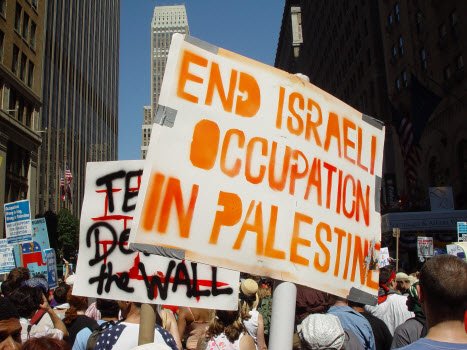The New York State primaries represented a time of change, with many fresh new faces entering the scene, such as recent Columbia student Julia Salazar. Indeed, every single one of the activist firebrand Linda Sarsour’s endorsements (except for Cynthia Nixon) ended up winning their respective elections.
I went to Columbia with Julia Salazar and I remember her being very active in Jewish Voice for Peace and Students for Justice in Palestine. This CUFI Christian-turned-PseudoJew, as I recall, made a complete 180-degree transformation following a trip to the Palestinian-controlled West Bank, a.k.a. Judea and Samaria. I have heard this story over and over again: someone raised to be unequivocally, almost robotically pro-Israel, to deny every Israeli imperfection, who suddenly becomes “enlightened” when they cross over the Green Line due to peer pressure or simple curiosity. They are led to believe that their entire upbringing was a huge lie and consult with the Palestinian side to rebuild their entire narrative.
Many of these candidates were able to both appease their Zionist and anti-Zionist supporters by treading the “Middle Way” – the approach that most Democrats deem as the “fairest”: That Israel must end the “occupation” of the Palestinian people.
 The strategy is brilliant because it means completely different things for different people. It could mean anything from granting Israeli citizenship for Palestinians living in Area C, the region of the West Bank (Judea and Samaria) governed by Israel, for the staunchest of Zionists, to Israel’s complete withdrawal from Judea and Samaria for the J-Street types to make way for a Palestinian State, to the complete annihilation of the State of Israel among those who believe that the Jews “occupied” the entire territory from its rightful owners, the Arabs, in 1948. In essence, it’s a nice little strategic game of Choose your Own Adventure, a brilliant psychological maneuver. Especially given that the Democratic Party is more heterogeneous in its approach to Israel than ever before.
The strategy is brilliant because it means completely different things for different people. It could mean anything from granting Israeli citizenship for Palestinians living in Area C, the region of the West Bank (Judea and Samaria) governed by Israel, for the staunchest of Zionists, to Israel’s complete withdrawal from Judea and Samaria for the J-Street types to make way for a Palestinian State, to the complete annihilation of the State of Israel among those who believe that the Jews “occupied” the entire territory from its rightful owners, the Arabs, in 1948. In essence, it’s a nice little strategic game of Choose your Own Adventure, a brilliant psychological maneuver. Especially given that the Democratic Party is more heterogeneous in its approach to Israel than ever before.
In a sense, they are right. There is an occupation. Sort of. But before you decide to draft up a nasty or laudatory comment, please read this article until the very end.
When people are “occupied”, it is implied they are indigenous
Think of every other situation where there was an “occupation” in the past. Morocco occupying Western Sahara. Turkey occupying North Cyprus. Russia occupying Ukraine. In every single situation, the inhabitants who were “occupied” were indigenous. The term “occupier” refers, in every instance, to an external colonial power. Therefore, to say that Israel is “occupying” or “stealing” land, even as self-proclaimed Zionists who believe that Judea and Samaria belong to the Palestinian Arabs, has a dangerous connotation, as it denies the inalienable Jewish historical, religious, cultural, ethnic, and physical connection to the land. The term “occupation”, in fact, was originally used by the PLO as a semantic tool to undermine the Jewish indigenous connection, which was universally known and taken for granted before the founding of the PLO. The PLO is actually an organization whose entire raison-d’être is to erase Jewish history and promote an alternate revisionist reality whereby “Palestinians,” a term they made up, are indigenous and not really just nomadic Arabs.
Typically, when you go deeper into a discussion about the nature of the “occupation” of “Palestinian Land”, you learn that the individuals are either uninformed about the Jewish indigenous connection, believe both Palestinians and Jews are indigenous due to some twisty mental gymnastics, or believe that the entire land is occupied by Jews, from the river to the sea, exposing their true colors.
Judea and Samaria were also “occupied” by Great Britain and Jordan, and Gaza was “occupied” by Egypt
But who were they occupying?
If you really want to get into the nitty-gritty, you will learn that between 1948 and 1967, Gaza, Judea, and Samaria were “occupied” by Egypt and Jordan, respectively. Prior to that, Britain occupied the entirety of the land that now encompasses Israel and Jordan. In order for it to be an actual “occupation”, somebody has to be “occupied”. Since the term “Palestinian” to describe “Arab” wasn’t really used until 1964, when it was coined by the PLO to invent an indigenous people, and that prior to 1948 it was widely used to refer to the Jews who inhabited the region due to their aforementioned taken-for-granted indigenous status, it can be surmised that the British, and later, the Egyptians and Jordanians, were actually occupying Jewish land.
Before the change of strategy subsequent to the founding of the PLO, the major objection to the Jewish presence in Israel was due to a philosophy called Pan-Arabism, or the colonialist belief that Arabs should take over the entire territory and make it one giant Arab Ummah. The religious Muslims among them cited dar al islam, of the belief that once a territory is captured by Muslims it must always remain Muslim by the will of Allah. In either case, according to this overarching philosophy, Egyptians, Jordanians, Syrians, Saudis, and Iraqis are all one and the same, and all part of the Pan-Arabist setup, the future Ummah or Caliphate. As such, the Egyptians and the Jordanians cannot be occupying their own people or land. Therefore, the initial 1948 occupation by Jordan and Egypt is under the assumption that the land was, in fact, Jewish, or at least not Arab.
After the founding of the PLO, and the proliferating belief in the following years that the newly-coined term “Palestinian” to refer to Arabs referred to a separate indigenous entity, the “capture” of Judea, Samaria, Gaza, and even the Golan Heights to some, by Israel in the defensive war of 1967, suddenly meant we were occupying Palestine, despite the fact that a country or territory called Palestine, governed by a people called Palestinians, never actually existed.
Could we be occupying a people but not a land?
Typically, when I successfully debunk the notion that Israel is “occupying” or “stealing” Palestinian land, my adversary retorts: “but it is common knowledge that you are occupying a people, according to the international definition.”
They claim that Israel is “occupying” Palestine, because in Judea and Samaria, otherwise known as the West Bank, Palestinians vote for the Palestinian Authority Government but do not vote for those who actually govern them, meaning the Israeli Knesset. In fact, I do agree that in such a case, the Palestinian People or Arabs of Judea and Samaria, would indeed be occupied.
However, in the vast majority of cases, this argument is based on a complete misconception. 97% of Palestinian Arabs in Judea and Samaria live in Areas A and B, which are governed entirely by their own people, the Palestinian Authority. In Area A, security is entirely administered by the PA, whereas in Area B, there is security cooperation between Israel and the PA. In Area B, where a “foreign” power (meaning an entity that does not match that of the civilian population) shares military control with the local authorities, it can be argued that there is somewhat of a military occupation. However, governance in Areas A and B is Palestinian, and residents carry Palestinian passports, elect their representatives (or at least would be if Abbas weren’t serving his 13th year of a 4-year term), and function as an autonomous country, with the exception of border checkpoints between Israel and the Palestinian Authority territories, which were successfully built to ward off terror and prevent another intifada. It can be argued that checkpoints of a similar or even more arduous nature are present between other hostile and even less hostile nations, such as the US and Mexico. Here is a video that compares the two.
Only 3% of Palestinians live in Israel-controlled Area C, amounting to just a couple hundred thousand. These Palestinian Arabs carry Palestinian ID cards and Palestinian passports, and vote for the Palestinian Authority, who, contrary to popular beliefs, do govern Arab villages and towns within Area C, as the Oslo agreement specifies only Jewish security administration. This leaves day to day governance to Palestinian municipal leaders who report to the Palestinian authority, making the claim that Area C Palestinians don’t vote for those who govern them a highly problematic claim designed to make Israel look bad. However, the Palestinian minority in Area C is under Israeli military protection. However, since they are a minority of the inhabitants of that regional designation, it is also questionable whether they would be considered under military occupation. On a micro-level, perhaps, as their villages are governed by the Palestinian Authority but are under Israeli military control. On a macro/regional level, since Jews constitute the majority of that region, it does not constitute an occupation of a people overall.
Does this all mean there is an occupation of a people that needs to get sorted? I’m not so sure, especially since 1) Palestinians in Area C were offered Israeli citizenship and 2) they have the freedom to move to Area A or B, which are entirely or nearly entirely administered by the PA. But most don’t, because they make several times the salary working within the Jewish jurisdictions of Area C and living in the Arab towns nearby than what they would make had they lived in Areas A or B.
Where do the Oslo Accords fit into this?
Now that we’ve established that the actual “occupation” (if we consider 100% israeli security control an “occupation”) is only 3% of the magnitude that is generally thought, let’s zoom in on this particular situation. How did we get there?
In 1993, the Palestinian Liberation Organization (PLO) under Yasser Arafat signed the Oslo Agreement. This agreement mapped out the set-up we have today, as a stepping-stone to a future state if the Palestinians prove that they are trustworthy and don’t use their newfound autonomy and freedom of movement to commit terror. Unfortunately, they did just that, and have expressed the intention to continue to do so, meaning that as per the Oslo Accords, the process cannot advance. The current setup with Areas A, B, and C, are exactly as agreed upon by both in the Oslo Accords. So if the Palestinian leaders agreed that those who live in Area C are under Israeli protection, are they really occupied?
It can thus be argued that because Palestinian leaders signed the declaration on behalf of their subjects, they are not under a forceful military occupation. However, technically speaking, despite the fact that the “occupation” arose from an agreement with those “occupied”, it is a pretty decent argument that Palestinians in Area C are indeed living under the Israeli occupation, if they choose to live in an area governed by an Israeli municipal authority, since they are governed by a “foreign” entity they didn’t vote for. But that was entirely their choice to do so!
The Element of Choice
So frequently do we neglect the bottom line: the Palestinians in Area C choose to live there! As citizens of the Palestinian Authority, they are free to move to either Area A or B as they wish. So are they really occupied if they can easily move to a place where they are governed by their “elected” leaders? The truth is, they don’t want to live under their own leaders. They make between 3 and 10 times the salary working in Israel-controlled territory, and enjoy a better quality of life than their counterparts in Areas A and B, which brings us to our last point…
The Elephant in the Room
Ignoring the element of choice, the occupation is questionable from a human rights perspective. It is never okay for people who have rights of longstanding presence to be denied the right to vote for those who govern them.
However, as alluded to above, Arabs living under the Israeli “occupation” are way better off in terms of living standards than they would be under their own, which is why they aren’t choosing to live there. In fact, you rarely see Area C Palestinians protesting. Typically, Area C Palestinian Arabs live peacefully with their Jewish neighbors. It is typically those living in Areas A and B who protest “the occupation.” Given the above, it is hard to tell whether they are protesting for ideological reasons or because it’s simply unfair that some Palestinians are that much better off than they are. And the few Area C Palestinians that may be protesting do so for their Area A and B compatriots, to reduce the tension and avoid accusations of dual loyalty, similar to many Arab Israelis.
At the end of the day, occupation or not, those who are fighting to “end the occupation” are actually fighting for worse living conditions under a corrupt, kleptocratic government that pays terrorists and their families exorbitant salaries, for their beloved Palestinians. So, nice going guys.



